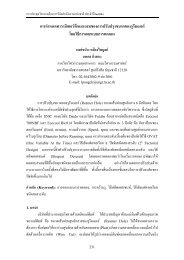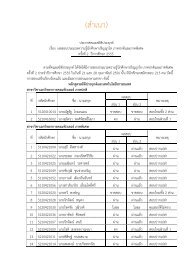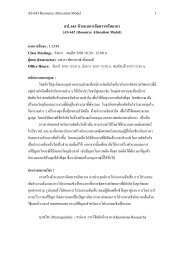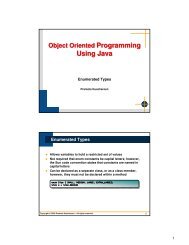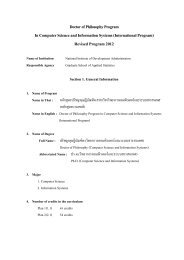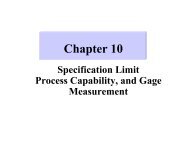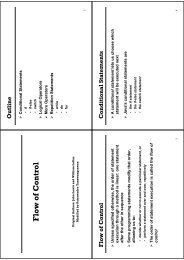ดาวน์โหลด All Proceeding - AS Nida
ดาวน์โหลด All Proceeding - AS Nida
ดาวน์โหลด All Proceeding - AS Nida
You also want an ePaper? Increase the reach of your titles
YUMPU automatically turns print PDFs into web optimized ePapers that Google loves.
4. Results and discussions<br />
4.1 Simulation of conventional and heat integrated<br />
distillation column<br />
Results of simulation compare between conventional and<br />
heat integrated distillation column (HIDiC) was shown in Table 3 that<br />
HIDiC consumed less energy than conventional. To reach as objective<br />
function the simulation will be based on process parameters and<br />
configuration of heat integrated distillation column.<br />
Table 3. Comparison of specific heat duty between conventional and<br />
heat integrated distillation column<br />
Parameters Conventional HIDiC<br />
Mash feed rate (F), kmol/h 2335 2335<br />
Reflux ratio mash column(R 1) 3 3<br />
Reflux ratio rectifying column(R 2) 200 200<br />
Volume fraction of ethanol in distillate of mash column (XD1) 0.6 0.6<br />
Volume fraction of ethanol in distillate of rectifying column (XD2) 0.95 0.95<br />
Distillate flowrate of rectifying column (D2), kmol/h 70 70<br />
Specific heat duty (QR/D), GJ/mol 1.203 0.974<br />
4.2 Sensitivity Analysis<br />
The objective of this process is to evaluate the influence of<br />
main variables on the energy consumption, to decide which variables<br />
should be optimized [7]. And fig. 5a-e show the effect of reflux ratio of<br />
mash column (R1), reflux ratio of rectifying column (R2), volume<br />
fraction of ethanol in distillate of mash column (XD1), distillate flow rate<br />
of rectifying column (D2) and feed stage of mash column (NF1) on the<br />
specific heat duty while the other parameters are constant. Relationship<br />
of each main parameter and specific heat duty can be described as<br />
below;<br />
• More reflux ratio of mash column (R1), more energy<br />
consumes.<br />
• Vary of rectifying column’s reflux ratio (R2) do not<br />
effect much to total specific heat duty.<br />
• More ethanol composition of distillate of mash<br />
column (XD1), less energy consumes.<br />
• More distillate flow rate of rectifying column (D2), less energy consumes.<br />
• Vary of feed stage of mash column (NF1) do not effect<br />
much to total specific heat duty.<br />
159<br />
From the sensitivity analysis it can conclude that only 3<br />
parameters which are reflux ratio of mash column (R 1), volume fraction<br />
of ethanol in distillate of mash column (X D1) and distillate flow rate of<br />
rectifying column (D 2) effected to energy consumption. To optimize<br />
distillation process only these 3 parameters will be varied and the<br />
design of experiment is shown as table 2.<br />
Fig. 5a Relation between reflux ratio of mash<br />
column and specific heat duty<br />
Fig. 5b Relation between reflux ratio of rectifying<br />
column and specific heat duty<br />
Fig. 5c Relation between ethanol composition of distillate<br />
of mash column and specific heat duty




